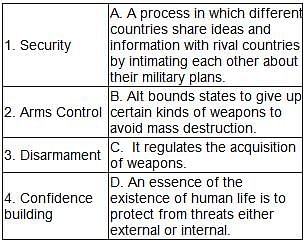Test: Conflict and Peace Study - UGC NET MCQ
10 Questions MCQ Test - Test: Conflict and Peace Study
Consider the following statements regarding Biological and Toxin Weapons Convention (BTWC)
1. It is a disarmament treaty that effectively bans biological and toxin weapons by prohibiting their development, production, acquisition, transfer, stockpiling and use.
2. It was the first multilateral disarmament treaty banning an entire category of weapons of mass destruction (WMD).
3. India is a signatory
Which of the above are correct?
Consider the following statements about Chemical Weapon
1. Chemical weapons are classified as weapons of mass destruction (WMD).
2. Nerve gas, tear gas and pepper spray are three modern examples of chemical weapons.
Select the correct answer using the code given below:
| 1 Crore+ students have signed up on EduRev. Have you? Download the App |
Match the following pairs and select the correct answer:


Consider the following statements about Biological Weapon
1. The 1972 Biological Weapons Convention (BWC) bans the development, production, acquisition, transfer, stockpiling and use of biological weapons.
2. The defensive biological research for prophylactic, protective or other peaceful purposes is prohibited by the BWC.
Select the correct answer using the code given below:
Which of the following statement(s) is/are true regarding the concept of Dual Deterrence?
A) Dual Deterrence is a strategy used by the US to keep two sides from going to war by making vague assurances.
B) The US does not pledges to aid Taiwan in its self-defence if attacked by China but does not explicitly denounce any efforts by Taiwan to declare full independence.
C) Deterrence has more positive aspects than negatives, including stopping World War III.
D) Dual Deterrence is a strategy used by China to maintain peaceful relations with its neighbours.
Choose the correct option:
Consider the following statements regarding the Credible Minimum Deterrence (CMD) policy:
I. It underlines no first use (NFU) with an assured first strike capability.
II. This doctrine asserts that nuclear weapons are solely for deterrence.
Which of the above statements is/ are correct?
Which one of the following statements about the Missile Technology Control Regime is not correct?
Consider the following statements with reference to the Conflicts in Urban Area:
1. Urban warfare shows a decrease in the rate of mortality over the last decade.
2. Currently, United Nations have no specific treaty dealing with war in urban areas.
Which of the statements given above is/are correct?
Read the following statements about 'Disarmament':
(A) Disarmament requires all states to give up certain kinds of weapons.
(B) The Biological Weapons Convention (1972) and the Chemical Weapons Convention (1993) banned the production and possession of these weapons.
(C) The superpowers, the US and the Soviet Union, also gave up weapons of mass destruction.
Choose the correct option.

















